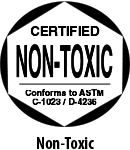
Intense pigment and high definition are the trademark of Duncan E-Z Stroke® Translucent Underglazes.
Cone 06 chips have been fired flat in oxidation on white earthenware body. S-2101 Crystal Clear Brushing was applied over the underglaze.
Cone 6 chips have been fired flat in oxidation on white stoneware body.
Cone 10 chips have been fired flat in reduction on white stoneware body.
SW-001 Stoneware Clear Glaze was applied over the underglaze.
SW-004 Zinc-Free Clear was applied over EZ010 French Brown, EZ033 Ivy Green, EZ037 Black, EZ038 Medium Mahogany, EZ071 Dark Olive
Duncan E-Z Stroke® have a definite see-through quality, even when one color is applied over another. They should not be used for solid-color coverage, but for design work, simulated china painting techniques, plaid effects or any other technique where a shaded or two-tone effect is desired. E-Z Strokes® are also the preferred underglaze color medium for outlining and detailing, including eyes, personalizing with names and dates, and accenting design work.
Perfect for brushwork, airbrushing and antiquing, helping you achieve the look of watercolor or detailed shading on greenware or bisque.
E-Z Stroke® translucent underglaze colors are most often used under a glaze. Apply 1 coat for translucent designs to 04 bisque, greenware, soft-fired bisque or unfired glazed ware. For rich depth and shading, apply additional thin coats. Fire to shelf cone 04. Apply Clear Glaze, or other suitable glaze of choice, stilt and fire to shelf cone 06. Water cleanup. Firing range cone 06 to cone 6.


Duncan E-Z Stroke® glazes are Non-Toxic. Dinnerware safe when clear glaze is applied.
Brushwork – Even though E-Z Strokes® are premixed to a light-cream consistency, at times it may be necessary to add water or Thin ‘n Shade to reach the desired consistency – wash, milk or light cream – for the specific effect you want to achieve. Place some E-Z Stroke® on a glazed tile or palette, which allows more control of the amount and location for color picked up by your brush. Apply one coat to greenware or cone 04 bisque. Use as large a brush as is practical and keep it well saturated for smooth, even brushstrokes. If your brush seems to drag when applying color to ware, this will indicate that the color is too thick and that a drop or two of water or Thin ‘n Shade is needed to thin the color to the proper working consistency. For shaded brushwork, load the brush with color, then tip or side load the brush with a second color.
Over Other Underglazes – E-Z Stroke® colors are very effective when applied over each other or over opaque underglazes. They can be used in design over a background of sponged or stippled color as well as over solid-color backgrounds. Whether they are used as the design or as a shading for other underglazes, keep in mind that they are translucent and might be altered in color by the color used underneath them.
Airbrushing – The concentrated color strength of E-Z Stroke® colors is ideal for use in airbrush decoration. Thin the color with Thin ‘n Shade or water, using two parts of Thin ‘n Shade to one part color. Airbrush the thinned color onto the greenware, passing over the desired area(s) until the intensity of the color on the ware is the equivalent of the color in the jar.
Banding – The one-stroke E-Z Stroke® colors are ideal for banding on color. Thin the color with water or Thin ‘n Shade to a milk or light-cream consistency, and band on one coat to greenware or over a base-coat color. Be sure to center piece on banding wheel.
Spattering – Thin the E-Z Stroke® color with water or Thin ‘n Shade to a milk consistency and use a stiff brush to spatter the color onto the base-coated or decorated ware.
Sponging – Place some E-Z Stroke® color on a glazed tile, add water or Thin ‘n Shade and mix to the consistency specified by the technique you are using (often milk or thin cream). Spread the color shallowing over the tile with a palette knife. Use a slightly dampened sponge to apply one coat of color directly to ware or over a base-coat color in patterns or to create background areas, letting the underlying surface show through here and there. More than one color can be sponged on a single item.
Stenciling – Thin the E-Z Stroke® color with water or Thin ‘n Shade to the consistency of thin cream. Apply one coat of the thinned color through the stencil opening with a sponge or brush onto the ware or over a background color.
Stippling – Place some E-Z Stroke® color on a glazed tile and thin with water or Thin ‘n Shade to a milk or light-cream consistency. Use your Deerfoot Stippler brush to stipple on one coat of color with quick up-and-down pouncing strokes to ware or over background color.
Antiquing – To use E-Z Stroke® as an antiquing medium, mix the color with water to make a thin wash. Use a small unwaxed cup and a palette knife to mix the color. Do not thin the entire jar. Apply the color wash the cone 04 bisque, using as large a brush as is practical. Wipe the piece down with a dampened sponge to remove the excess color from the raised areas. Clean the sponge frequently. When the piece is thoroughly dry, glaze with a clear or transparent glaze and fire to cone 06.
Over a Glaze (Majolica Technique) – E-Z Stroke® colors can be used effectively over unfired non-moving glazes and then fired to witness cone 06. Designs, patterns or scenes can be painted over nonmoving glazes. The E-Z Stroke® colors should be thinned with water or Thin ‘n Shade to a consistency no heavier than light cream and applied in one or two light coats rather than a heavy coat. Too heavy or too think an application may produce a textured effect or blisters on the color area. Unusual effects can also be obtained when E-Z Strokes® are applied over flowing glazes such as glosses. The colors will change somewhat in tone depending on the choice of color glaze used, the shape of the bisque piece, and the cone to which it is fired. As the glaze flows during the firing, the E-Z Strokes® will also flow, creating one-of-a-kind effects.
Bisque Application – Although E-Z Strokes® were primarily designed for application on greenware, E-Z Stroke® colors are used on cone 04 bisque when an antiqued finish is desired and can be used successfully on bisque just as you would use them on greenware if you lightly dampen the bisque with clean water before applying the E-Z Stroke® color. Bisque is very porous and unless it is pre-dampened, it will absorb the moisture from the color too quickly, making a smooth stroke impossible to obtain. If E-Z Stroke® is used for design on bisque, it is not necessary to fire the piece before applying a glaze, providing the E-Z Stroke® is thoroughly dry and the glaze is applied with a fully loaded brush so the underlying colors are not disturbed. There will be slight color variations between pieces fired to only cone 06 compared to those colors applied to greenware and bisque fired hotter to cone 04.
As a Colorant – E-Z Stroke® colors can be blended or mixed together to create additional color hues. They can also be used to tint French Dimensions and Fired Snow.. The usual mixing proportions are no more than 50% E-Z Stroke®. They are also ideally suited for coloring or marbleizing ceramic, porcelain or stoneware casting slip because they are strong, highly concentrated colors. When mixing or color blending, we recommend that a small fired test sample be made to determine the proper mixture for the desired effect.
On Porcelain and Stoneware – E-Z Stroke® colors have been designed to perform through a wide firing range. Most of the colors fire true to color up to a cone 6 firing, but some colors may fade or change color at such a high temperature, due to their chemical nature. Test-firing is recommended. Thin with water or Thin ‘n Shade to the consistency specified by the particular decorating technique you are using and apply to dampened porcelain or stoneware greenware, or dampened cone 018-016 bisque. Fire to the maturing cone recommended by the clay manufacturer.